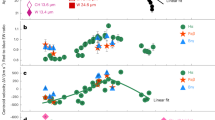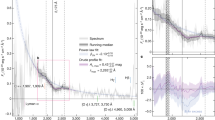Abstract
A large amount (about three solar masses) of cold (18 K) dust in the prototypical type II supernova remnant Cassiopeia A was recently reported1. It was concluded that dust production in type II supernovae can explain how the large quantities (∼ 108 solar masses) of dust observed2 in the most distant quasars could have been produced within only 700 million years after the Big Bang. Foreground clouds of interstellar material, however, complicate the interpretation of the earlier submillimetre observations of Cas A. Here we report far-infrared and molecular line observations that demonstrate that most of the detected submillimetre emission originates from interstellar dust in a molecular cloud complex located in the line of sight between the Earth and Cas A, and is therefore not associated with the remnant. The argument that type II supernovae produce copious amounts of dust is not supported by the case of Cas A, which previously appeared to provide the best evidence for this possibility.
This is a preview of subscription content, access via your institution
Access options
Subscribe to this journal
Receive 51 print issues and online access
$199.00 per year
only $3.90 per issue
Buy this article
- Purchase on Springer Link
- Instant access to full article PDF
Prices may be subject to local taxes which are calculated during checkout



Similar content being viewed by others
References
Dunne, L., Eales, S., Ivison, R., Morgan, H. & Edmunds, M. Type II supernovae as a significant source of interstellar dust. Nature 424, 285–287 (2003)
Bertoldi, F. et al. Dust emission from the most distant quasars. Astron. Astrophys. 406, L55–L58 (2003)
Wilson, T. L. et al. The molecular gas toward Cassiopeia A. Astron. Astrophys. 280, 221–230 (1993)
Weinreb, S., Barrett, A. H., Meeks, M. L. & Henry, J. C. Radio observations of OH in the interstellar medium. Nature 200, 829–831 (1963)
Hughes, D. W. Did Flamsteed see the Cassiopeia-A supernova. Nature 285, 132–133 (1980)
Reynoso, E. M. & Goss, W. M. Very Large Array observations of 6 centimeter H2CO in the direction of Cassiopeia A. Astrophys. J. 575, 871–885 (2002)
Loinard, L., Lequeux, J., Tilanus, R. & Lagache, P. O. Submillimeter observations of Cassiopeia A. Rev. Mex. Astron. Astrofis. 15, 267–269 (2003)
Holland, W. S. et al. SCUBA: A common-user submillimetre camera operating on the James Clerk Maxwell Telescope. Mon. Not. R. Astron. Soc. 303, 659–672 (1999)
Rieke, G. H. et al. The Multiband Imaging Photometer for Spitzer. Astrophys. J. Suppl. 154, 25–28 (2004)
Lemke, D. et al. ISOPHOT—capabilities and performance. Astron. Astrophys. 315, L64–L70 (1996)
Bogun, S. et al. First data from the ISOPHOT FIR Serendipity survey. Astron. Astrophys. 315, L71–L74 (1996)
Liszt, H. & Lucas, R. 86 and 140 GHz radiocontinuum maps of the Cassiopeia A SNR. Astron. Astrophys. 347, 258–265 (1999)
Bieging, J. H. & Crutcher, R. M. VLA observations of 1667 MHz OH absorption toward Cassiopeia A. Astrophys. J. 310, 853–871 (1986)
Crutcher, R. M. Nonthermal OH main lines and the abundance of OH in interstellar dust clouds. Astrophys. J. 234, 881–890 (1979)
Harju, J., Winnberg, A. & Wouterloot, J. G. A. The distribution of OH in Taurus Molecular Cloud-1. Astron. Astrophys. 353, 1065–1073 (2000)
Ossenkopf, V. & Henning, Th. Dust opacities for protostellar cores. Astron. Astrophys. 291, 943–959 (1994)
Hines, D. C. et al. Imaging of the Supernova Remnant Cassiopeia A with the Multiband Imaging Photometer for Spitzer (MIPS). Astrophys. J. Suppl. 154, 290–293 (2004)
Dwek, E. The detection of cold dust in Cassiopeia A: Evidence for the formation of metallic needles in the ejecta. Astrophys. J. 607, 848–854 (2004)
Morgan, H. L., Dunne, L., Eales, S. A., Ivison, R. J. & Edmunds, M. G. Cold dust in Kepler's supernova remnant. Astrophys. J. 597, L33–L36 (2003)
Blair, W. P. in 1604-2004: Supernovae as Cosmological Lighthouses (eds Turatto, M., Shea, W. R. J., Benetti, S. & Zampieri, L.) (ASP Conf. Ser., Astronomical Society of the Pacific, San Francisco) in the press) also available at 〈http://arxiv.org/abs/astro-ph/0410081〉
Rothenflug, R., Magne, B., Chieze, J. P. & Ballet, J. Hydrodynamic model of Kepler's supernova remnant constrained by EINSTEIN and EXOSAT X-ray spectra. Astron. Astrophys. 291, 271–282 (1994)
Kinugasa, K. & Tsunemi, H. ASCA observation of Kepler's supernova remnant. Publ. Astron. Soc. Jpn 51, 239–252 (1999)
Arendt, R. G. An infrared survey of Galactic supernova remnants. Astrophys. J. Suppl. 70, 181–212 (1989)
Wright, M., Dickel, J., Koralesky, B. & Rudnick, L. The supernova remnant Cassiopeia A at millimeter wavelengths. Astrophys. J. 518, 284–297 (1999)
Acknowledgements
We thank H. Liszt and J. Bieging for making their molecular line observations available to us. This work is based on observations made with the Spitzer Space Telescope and the Infrared Space Observatory, ISO. We acknowledge access to the SCUBA data archive operated by CADC. We thank L. Dunne, H. Morgan, S. Eales and R. Ivison for discussions.
Author information
Authors and Affiliations
Corresponding author
Ethics declarations
Competing interests
The authors declare that they have no competing financial interests.
Rights and permissions
About this article
Cite this article
Krause, O., Birkmann, S., Rieke, G. et al. No cold dust within the supernova remnant Cassiopeia A. Nature 432, 596–598 (2004). https://doi.org/10.1038/nature03110
Received:
Accepted:
Issue Date:
DOI: https://doi.org/10.1038/nature03110
This article is cited by
-
Production of dust by massive stars at high redshift
The Astronomy and Astrophysics Review (2011)
Comments
By submitting a comment you agree to abide by our Terms and Community Guidelines. If you find something abusive or that does not comply with our terms or guidelines please flag it as inappropriate.



